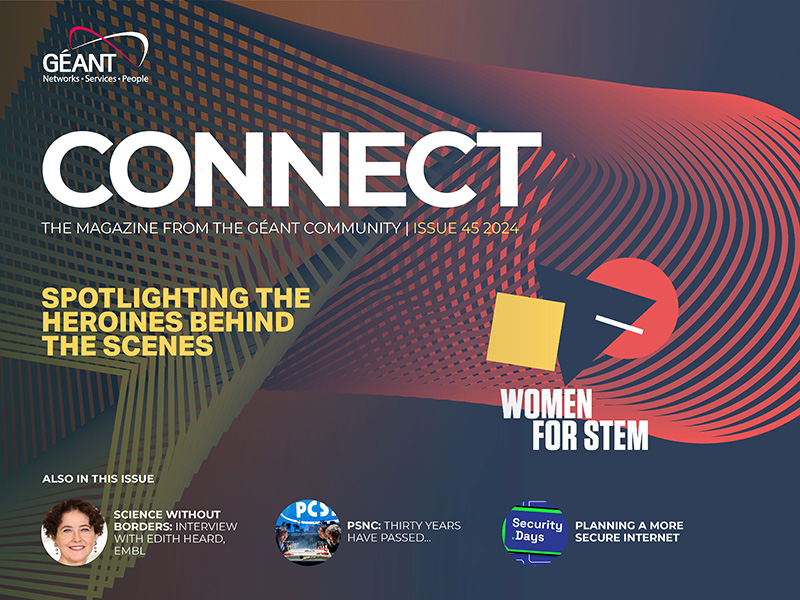Words: Tommi Kutilainen, CSC
2023 marked the 40th anniversary of the Funet (Finnish University and Research Network) and the 35th anniversary of Finland’s connection to the global internet. CSC’s Funet can be proud of its many achievements and the future also looks bright; Funet and online services have become even more important in enabling Finnish science and the development of higher education.
In Finland, the need for a network connecting universities was identified in the early 1980s. In 1983, the Ministry of Education set up the Funet project, in which a small group of IT experts with an interest in telecommunications was given the task of developing a data network linking universities. Funet was founded on 29 December 1983, and in the following year Funet connected the universities’ mainframe computers.
Here we highlight some of the major milestones in Funet’s 40-year journey.
First message on the internet
On Thursday 1 December 1988, the first routing test was carried out, allowing IP packets to pass from Finland via NORDUnet to the USA. This connected Finland to the international Internet via the Funet network. The following message can be seen as the beginning of the Finnish Internet.
“This is a first test, please disable if there any problems. We now have 250 more nets in the RIP updates, thats about 10 packets being broadcast every 30:th second…”

Nic.funet.fi and the Linux world conquest
Linux is the most famous and probably the most important open-source software success story. The Linux family of operating systems can now be found on everything from home appliances and Android phones to home computers, from servers running people’s common services to supercomputers grinding out heavy scientific computing. Even in data networks, servers and routers run on Linux.
Linux’s birthday is 24 August 1991, when Linus Torvalds wrote in the comp.os.minix newsgroup that he was doing a free operating system: “I’m doing a (free) operating system (just a hobby, won’t be big and professional like gnu).” On 17 September 1991, Torvalds made Linux version 0.01 openly available to everyone via the CSC file server nic.funet.fi. The file server is still in use today and one of the longest running internet services in Finland.

Electronic identification
As the number of online services increased, the need for electronic identification of the individual emerged. The project for electronic identification in universities was launched in 2000 with funding from the Ministry of Education and universities of applied sciences joined a little later. This led to the creation of the Haka trust network, which provides an authentication service that allows users to log in with their home organisation’s IDs to services provided by other organisations.
At this time, electronic identification was being developed by many organisations and Funet was a major contributor. Early experiments with electronic identification have enabled a wide range of online services in what we consider to be our everyday life.
Funet CERT and information security
The growth in the number of users and new services made the internet more vulnerable. Computer Emergency Response Teams (CERTs) were set up in different countries to respond quickly to various network security threats. In 1995 Funet set up Finland’s first CERT to share information about network security threats and guidelines for responding to them.
Quantum technology
The quantum computer is seen not only as a revolutioniser in computational science, but also as a very powerful crypto-breaker, so the preparations for the quantum age are also underway in the field of network technology. Funet is involved in building the first experimental network for quantum encryption.
High-capacity data connections
In the early 2000s, Funet introduced high-speed connections known as ‘light paths’, which are separate connections designed for the specific needs of research. One of the first users was the Metsähovi radio observatory in Kirkkonummi, Finland. The 10 Gbit/s light path was used to transfer measurement data collected by the Metsähovi radio telescope to research centers in Central Europe and the US. Previously, data had been transferred by mailing hard disks.
Funet has also tested the network’s performance over ultrafast data connections. In 2021, bits could be transmitted at 800Gbit/s over a distance of more than 2,000 km. In 2022, Funet and Sweden’s Sunet were able to transmit data at 400 Gbit/s over a distance of 10,000 km.
In 2023 and 2024, Funet will deploy the first 400 Gbit/s backbone connections, among the first NRENs in the world to do so.
In 2023, Funet, together with Sikt in Norway and Sunet in Sweden, provided the Eiscat3D research project with 4 Tbit/s connections between the data center in Kalix, Sweden and three antenna sites located at Kaaresuvanto in Finland, Skibotn in Norway and Kaiseniemi in Sweden.
The EISCAT 3D radar system provides three-dimensional views of the atmosphere and ionosphere phenomena.

Read or download the full magazine here







